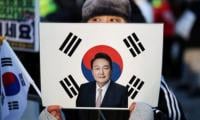PGII: an alternative to the BRI?
The writer holds a PhD from Massey University, New Zealand. He teaches at the University of Malakand.
We are living in the age of uncertainty. Last month, during the 48th G7 summit, held in Germany, member countries came up with a new initiative called the Partnership for Global Infrastructure Investment (PGII).
Oddly enough, projects already launched last year by the US Agency for International Development (USAID), the Millennium Challenge Corporation (MCC) US International Development Finance Corporation (DFC) as well as those implemented by the US Trade and Development Agency, Department of Transportation and Department of State have been combined together under the recently announced PGII.
It must be emphasized that the new plan is the relabelling, or rebranding of a strategy which was unveiled by the same group of countries last year. During the 47th G7 summit, held last year in the UK, US President Biden had come up with his version of the Beijing-inspired Belt and Road Initiative (BRI) and called it the Build Back Better World (B3W) plan.
“China has its Belt and Road Initiative, and we think that there’s a much more equitable way to provide for the needs of countries around the world’, US President Biden had announced. While the G7 countries never provided a clear roadmap and details about the financing mechanisms and institutionalization of the programme, there was immense optimism among Western thinktanks and media. One study asserted that “regardless of its strategic intent, [the] B3W still has the potential to improve global welfare, reinforce good governance systems, and strengthen partnerships”.
Now a year after the B3W, the G7 has come up with the PGII. What prompted member countries to rebrand the B3W is yet to be clarified. This attempt to rename the B3W as PGII to counterbalance Beijing’s BRI indicates a lack of clear roadmap and framework among the G7 members for resolving global development challenges and countering the growing influence of China.
It is unclear what impact the B3W made at all. It has not shown any tangible progress so far, and there was no information about the initiative’s timeframe as well as sources of financing from member countries. Therefore, during the 48th summit held under Germany’s chairmanship in 2022, the G7 members pledged to mobilize $ 600 billion until 2027 to narrow the global investment gap.
Biden has announced that the US aims to mobilize $200 billion for the PGII over the next five years through grants, federal financing, and leveraging private-sector investments. “The United States and its G7 partners will seek to mobilize additional capital from other like-minded partners, multilateral development banks, development finance institutions, sovereign wealth funds, and more,” he added.
The world currently faces a $40 trillion infrastructure gap, and the global economy has been terribly affected by Covid-19. When there were some signs of recovery, the Russia-Ukraine war started, and it has now created ripples in the global energy and food markets. Given that there is immense global demand for infrastructure, more so in developing countries, these infrastructure-financing initiatives should be pursued and not be perceived as a zero-sum game.
Projects like the BRI, the B3W and the PGII are a welcome step as they provide cash-strapped economies with an alternative source of financing. After the launch of the BRI, Western response largely focused on highlighting the shortcomings of the BRI. The US and its key allies were critical of the President Xi-inspired ‘project of the century’, citing various reasons from strategic and security to financial soundness, debt and financial risks to environmental and social concerns.
The BRI was called a ‘Chinese Marshall plan’, a ‘neo-colonial tool’ and a ‘debt trap’ aimed at destroying developing countries’ economies and sovereignty. While Beijing continued funding infrastructure projects and expanded its influence and outreach, the West was unable to offer an alternative to developing countries which needed financial resources to build and upgrade their infrastructure. A report released by AidData, an international development research lab based at the William and Mary’s Global Research Institute in the US, has pointed out that during the last 20 years, Beijing has financed around 13,427 projects worth $843 billion in 165 countries. All this clearly indicates that China has been pursuing a large role at the global stage.
The US/G7-led PGII aims to tackle pressing global challenges including the climate crisis, global energy security through investments in climate-resilient infrastructure and to expand information and communications technology (ICT) networks and infrastructure. When asked about the PGII, Chinese foreign ministry spokesperson Zhao Lijian stated that “China continues to welcome all initiatives to promote global infrastructure development”… We believe that there is no question that various related initiatives will replace each other. We are opposed to pushing forward geopolitical calculations under the pretext of infrastructure construction or smearing the Belt and Road Initiative.”
However, there were some scathing comments and analysis from certain quarters. For example, Chen Weihua, the chief of China Daily EU Bureau Chief based in Brussels wrote a scathing oped in China Daily on the new initiative. “The Partnership for Global Infrastructure and Investment launched by G7 leaders during their just-concluded summit in the Bavarian Alps, Germany, has become an instant laughingstock for its empty rhetoric and its bid to “counter” the China-led Belt and Road Initiative”, he wrote on the new plan.
“To begin with, the PGII is nothing new but a rebranding of the “Build Back Better World” or “B3W” plan…In the past year, no progress on the B3W has been reported…the PGII does not include the most common infrastructure projects such as roads, bridges, railways and power plants despite the fact that they are the most-needed facilities in the developing world…The sad truth is that the G7 will skip those real infrastructure projects. Developing countries need more infrastructure projects, the more the better. So infrastructure initiatives should never be a zero-sum competition between big powers”, Chen Weihua’s oped added.
It is too early to decide how the BRI and PGII will compete with or complement each other. But the EU already has its Global Gateway project, announced last year. The EU-led initiative also focuses on physical infrastructure such as ‘clean transport corridors, clean power transmission lines’. Under the Global Gateway, EU member states have pledged about 300 billion euros between 2021 and 2027, using the brand ‘Team Europe’. Only time will tell whether and how the PGII and Global Gateway succeed in building resilient infrastructure and countering China’s BRI and Beijing’s rising power at the global stage.
Email: muradali.uom@gmail.com
-
 North West Raps About Piercings, Tattoos And Skipping School In New Song
North West Raps About Piercings, Tattoos And Skipping School In New Song -
 Teddi Mellencamp Shares Hopeful Health Update Amid Cancer Battle: 'Cloud Is Lifting'
Teddi Mellencamp Shares Hopeful Health Update Amid Cancer Battle: 'Cloud Is Lifting' -
 Prince William Makes Clear The Conditions He Has For Meeting Prince Harry
Prince William Makes Clear The Conditions He Has For Meeting Prince Harry -
 Sara Foster Slams Age Gap Relationship After 'blah' George Clooney Date
Sara Foster Slams Age Gap Relationship After 'blah' George Clooney Date -
 Jennifer Garner Recalls Enduring Ben Affleck’s Intense Beyoncé ‘Halo’ Phase
Jennifer Garner Recalls Enduring Ben Affleck’s Intense Beyoncé ‘Halo’ Phase -
 Prince Harry’s Mental Health Ends Up At Stake As Meghan Moves Him To 'second Fiddle'
Prince Harry’s Mental Health Ends Up At Stake As Meghan Moves Him To 'second Fiddle' -
 Bradley Cooper On Who His Mother Thinks Is The World’s Best Actor
Bradley Cooper On Who His Mother Thinks Is The World’s Best Actor -
 Meghan Markle Offers Glimpse Into Intimate Dance Moment With Harry Amid Split Rumors
Meghan Markle Offers Glimpse Into Intimate Dance Moment With Harry Amid Split Rumors -
 Jon Bon Jovi Joins The Viral 2016 Throwback Trend With Nostalgic Photos
Jon Bon Jovi Joins The Viral 2016 Throwback Trend With Nostalgic Photos -
 Kate Middleton Hailed For Her Lack Of ‘obligation’ As Well As Altruistic, Selfless Qualities
Kate Middleton Hailed For Her Lack Of ‘obligation’ As Well As Altruistic, Selfless Qualities -
 Jason Momoa Says Being With Beau Adria Arjona Feels 'perfect'
Jason Momoa Says Being With Beau Adria Arjona Feels 'perfect' -
 Idris Elba Says One Mix-up Nearly Cost Him A Knighthood From King Charles
Idris Elba Says One Mix-up Nearly Cost Him A Knighthood From King Charles -
 Andrew Mountbatten Windsor Incurs Anger Of Biggest Royal
Andrew Mountbatten Windsor Incurs Anger Of Biggest Royal -
 Megan Fox, Machine Gun Kelly's Relationship 'is Just About Co-parenting'
Megan Fox, Machine Gun Kelly's Relationship 'is Just About Co-parenting' -
 Prince Harry, Meghan Markle Warned They Can’t Fool Brits Because It Won’t Land
Prince Harry, Meghan Markle Warned They Can’t Fool Brits Because It Won’t Land -
 South Korea’s Ex-president Yoon Suk Yeol, Sentenced To 5 Years In Prison: Key Details Explained
South Korea’s Ex-president Yoon Suk Yeol, Sentenced To 5 Years In Prison: Key Details Explained



